Auto loan securitization issuance has grown rapidly in China after a humble start in 2008. As the issuance picked up to meet auto financiers' funding needs, investors also benefitted from the stable credit performance of the underlying auto loan portfolios.
S&P Global Ratings believes mild competition in China's auto finance industry, stable product offerings, and the structural feature of the transactions underpin the robustness of the asset performance of auto loan asset-backed securities (ABS) in China. The low cumulative default rate and net losses reflect such performance. The short duration of ABS notes due to shorter tenor loans and mostly sequential repayment deal arrangements further limit investors' exposure to credit risks. We expect increasing disposable income per capita, high passenger car sales volume, the currently low penetration of auto financing, and financiers' ongoing funding needs will support the growth of the auto loan ABS market in China.
We believe certain economic, regulatory, and market factors will affect the development and performance of the China auto loan ABS the most (see table 1). This article discusses the market operation, deal structure, and credit performance of China's (retail) auto loans and auto loans ABS markets. Wholesale financing, such as auto dealer floor loans, are outside the scope of this article.
Table 1
| Most Relevant Factors In China's Auto Loan ABS Performance | |
|---|---|
| Factor | Outlook |
| Economic fundamentals | GDP growth remains at or above 6% before 2019; consumption's contribution to economic growth may increase; the current credit-fueled growth poses downside risk |
| Interest rate trends | Official benchmark lending rate remains stable, but market interest rate could be volatile; the risk of a significant deterioration in loan performance due to interest rate hike is remote because of the relatively low balance of each loan |
| Unemployment rate | Labor market conditions are stable for now |
| Household debt and disposable income | Relatively low leverage and increasing incomes of China's household continue to support debt serviceability |
| Passenger car sales volume | 2%-4% growth per annum in 2017-2019; future growth supported by upgrade demand in higher-tier cities and auto penetration into lower-tier cities |
| Regulatory framework | Regulators remain supportive of auto financing and securitization; regulatory requirements have helped financiers to improve underwriting and risk-management skills |
| Penetration of auto financing | Penetration of auto financing will continue to increase; each small increase in penetration can create a considerable amount of new auto loan demand due to the size of China's new car market |
| Financiers' funding needs | The surge of auto financing volume will fuel financiers' ongoing need for funding |
| Future development | The market will see more variety in the future, such as new assets (add-on value loans, used-car loans, etc.) |
Economic Trends In China
Economic fundamentals
China is the second-largest economy in the world in terms of GDP amount, with a huge diversified industrial base. The Chinese economy is characterized by a comparatively low level of GDP per capita due to the large population, but above-average growth prospects.
Table 2
| S&P Global Ratings' Economic Indicators For China | ||||||||||||
|---|---|---|---|---|---|---|---|---|---|---|---|---|
| 2015 | 2016 | 2017F | 2018F | 2019F | ||||||||
| Real GDP Growth (%) | 6.9 | 6.7 | 6.9 | 6.5 | 6.3 | |||||||
| Unemployment Rate (%) | 4.0 | 4.0 | 4.0 | 4.0 | 4.0 | |||||||
| CPI Inflation (%) | 1.4 | 2.0 | 1.6 | 2.2 | 2.4 | |||||||
| F--Forecast. Source: S&P Global Ratings. | ||||||||||||
A trade- and investment- led economic model; the country's GDP growth relies more on investment after the global financial crisis. Unlike the U.S., whose GDP growth is primarily driven by consumer consumption, China's GDP growth nowadays is supported by capital expenditure, and more recently consumption. Things, however, were quite different a decade ago.
Since China joined World Trade Organization in late 2001, trade and related investments in trade industries have been the key sources of economic growth, with much of that investment concentrated in manufacturing. Trade had explosively increased and fueled the tremendous economic growth before the global financial turmoil in 2008. An International Monetary Fund (IMF) report estimated that exports contributed over 30% in terms of value added to output growth as of 2008, which is a striking figure for an economy of the size of China.
After the global financial crisis, the collapse of global trade crippled the country's exports and caused many factories to shut down, threatening to increase unemployment. To counter potential for social unrest resulting from this, and to support the economy during the financial crisis, the government of China initiated a major stimulus package to inject Chinese renminbi (RMB) 4 trillion into the economy. The plan was largely for a boost to public infrastructure as well as corporate investment, aiming to quickly create millions of jobs to maintain employment growth. Capital investment has thereafter become the new growth driver. The investment, however, is heavily reliant on credit financing, and the sustainability of the credit growth--and therefore of the economy--has now become a major cause for concern.
Credit-fueled growth poses downside risk. During the global financial crisis, the government of China injected massive amounts of money into various sectors through loans from its state-owned banks to support the economy. This resulted in quick credit growth in the banking sector. In 2015, Chinese banks' balance sheet had grown to more than three times that in 2007. Most of the new loans were to midsize and large companies, especially state-owned enterprises (SOEs). SOEs, acting as a conduit for policy-driven investment and mostly in resources-intensive industries, are very diverse in their leverage and profitability profiles. The increasing level of corporate debt is intensifying the downside risks because of weakening borrower credit quality, amid slowing economic growth. This, together with the deteriorated operational performance, has created pressure on banks' asset quality.
China's outstanding incremental total social financing (TSF), a broad measure of credit and liquidity of the economy including off-balance sheet financing, reached a historical high of RMB18.3 trillion as of Nov. 30, 2017. The growth of China's outstanding TSF continues to outpace its economic expansion, particularly in 2009 (see chart 1). The total credit to the non-financial sector is now more than 250% of national GDP according to Bank for International Settlements (BIS).This has drawn broad concern on the sustainability of the economy's growth, even though it is the high domestic savings--rather than external wholesale debt--that supports the lending in China.
Chart 1

The composition of aggregate credit growth however shows bifurcation trends. The credit boom is primarily in the corporate sector due to large investment activities. These in turn result in overcapacity and elevated asset prices in many sectors, such as mining, cement, steel, petrochemicals, and real estate.
The household sector, on the other hand, represents only a small portion of the national debt (see chart 2). According to IMF reports, China's household debt ratio, though increasing, is consistent with the level for countries at a similar level of development, and much below that in more developed economies.
Chart 2

China's economic expansion has slowed down in recent years, with the balance of risks on the downside. The market consensus is that China needs more moderate, less credit-intensive growth to put the economy on a more sustainable growth path. Chinese policymakers also have adopted a steady pace in taking measures to reduce the credit intensity of economic growth and tried to put the country's economy on firmer financial footing. This is not an easy task in an economy burdened with industrial overcapacity and deteriorating profitability. But in 2017, the policymakers gained some ground and signs of slower credit growth are emerging. The pace of readjustment, however, is slow. Although some government officials have voiced concerns over rising leverage in China, the latest Chinese five-year plan calls for average growth of about 6.5% annually in the 2016-2020 period, which may still require continued credit growth.
Government's reform effort and its implications
The Chinese government is taking a number of steps to make its economy more resilient. Initiatives include emphases on economic rebalancing, determined efforts to reduce graft, measures to improve the business environment for private companies, and directives to delineate more clearly the fiscal responsibilities of different levels of the governments. There is also reform to liberalize the financial sector, including greater flexibility in the exchange rate regime, internationalization of the renminbi, and a very gradual opening of the capital account (for instance, the Shanghai-Shenzhen Stock Connect).
Rebalancing has progressed particularly in switching from manufacturing to services and from investment to consumption. As outlined in the twelfth and thirteenth five-year plans, the government is committed to transforming the economy to a more consumer- and service-based and less credit-driven one. The rationale behind this includes easing the social tension because of wealth inequality accumulated in the past decade, and reducing the reliance on external demand to prevent an abrupt stalling of the economy.
Economic rebalancing therefore surfaced. Since 2012, the nominal share of the manufacturing industry in the GDP has been declining steadily (see chart 3). Service sector activity first surpassed that of the manufacturing sector in terms of share of GDP in 2012. The most significant implications of this development was continued urban employment growth--the services sector is more labor-intensive than the manufacturing and construction sectors. This should support China's labor absorption and employment growth even with slower GDP growth. And it should lead to a more robust economy, as the services sector is less vulnerable to cyclical economic changes than are manufacturing and construction.
Chart 3
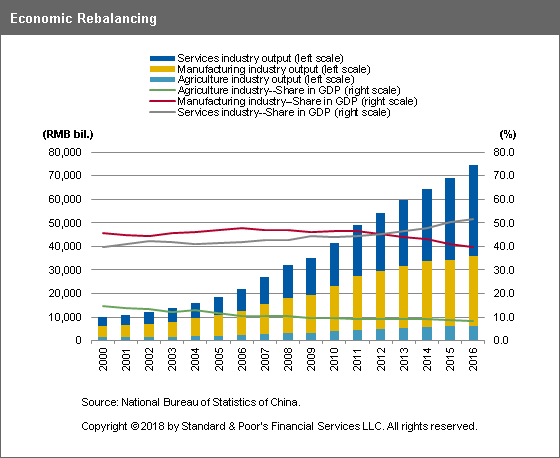
Rebalancing on the demand side is also underway, although its pace is relatively slow. Consumption growth has outpaced GDP growth since 2010, but the momentum seems to have moderated in recent years (see chart 4). The structurally low share of consumption, to some extent, could be attributed to China's unusually high household savings rate even when the income level increased, which is largely due to precautionary saving motives. The gross saving in China, defined as gross national income less total consumption, has remained around 50% of GDP since 2007, according to World Bank. The saving rate recently posted its first decline since 2010.
Chart 4
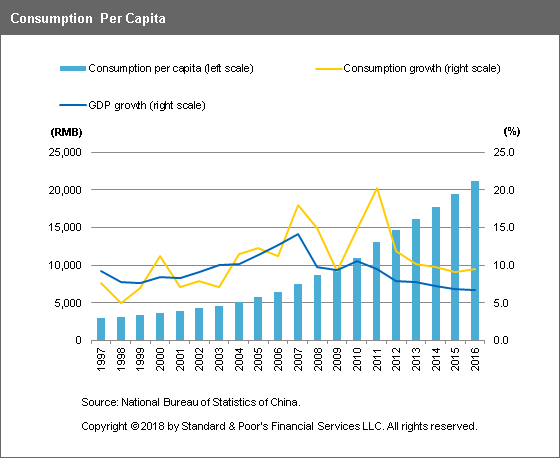
To address the side effect of high savings, China has made substantial investment in social security items to encourage spending now. The government's 2009 stimulus plan has increased health and pension spending. The recent five-year plan further suggests ways to improve social insurance to cover all residents in China, and to fully implement the supplementary health insurance program for jobless residents suffering from major diseases. With a stronger social safety system, household consumption is expected to pick up along with rising disposable income.
The government has attempted to make local government financing more transparent. Major changes have been made to promote greater transparency on local government borrowing. A greater number of infrastructure projects are now being financed by municipal bonds. Even if local government financing vehicles continue to borrow for public projects, the central government is pushing them to fund through the bond market. Foreign bond issuances have also been encouraged for some. These modes of financing require significantly more information disclosure on the part of local governments, and thus also improve the transparency of related governments' financial conditions.
Tightened funding reflects efforts to curb excessive interbank credit growth and rein in overall credit expansion in the economy. China's current liquidity tightening has come about because of the authorities' intensified efforts to rein in the leverage of financial institutions since mid-March 2017. S&P Global Ratings views the Chinese government's attempts to temper credit growth as appropriate, given the high indebtedness in key sectors of the economy. We expect the authorities to continue with this approach until they perceive that risks to financial stability have moderated. While this approach is likely to lead to more pressure on corporate debt in the near term, it could help mitigate medium-term systemic risk.
New bond issuance has reduced over the past several months, partly due to rising interest rates in the capital market since late 2016. This could lead to heightened refinancing risks for certain issuers, even though the funding gap has been largely filled by increased bank loans and equity raising. The interest-rate policy maneuvering again is sophisticated.
Interest-rate trends
The People's Bank of China (PBOC; the central bank) is responsible for the country's monetary policy setting and execution, with the primary objective of preventing and resolving financial risks and maintaining financial stability. The monetary instruments PBOC can leverage include benchmark interest rates, reserve requirement ratio, and open market operations. Interest rates decisions are made by PBOC's Monetary Policy Committee. Unlike other central banks, which only set the overnight rate, the PBOC sets rates for multiple maturities ranging from overnight to five years.
Chart 5 shows the one year benchmark rate set by the PBOC from 1995 to 2017. Starting from late 2014, the PBOC has cut the benchmark rate consecutively, reflecting the slower momentum in the macroeconomic environment.
Chart 5
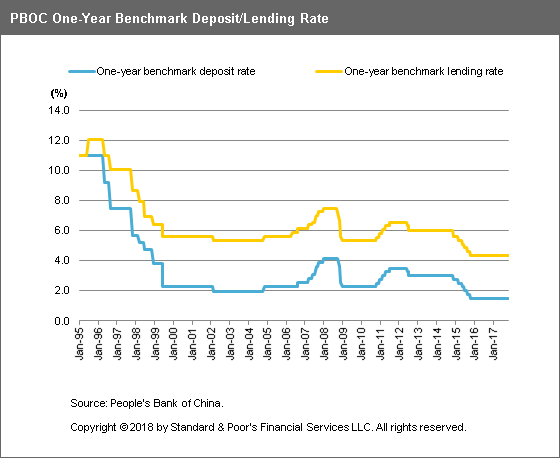
Market interest rates, however, could be volatile even with the stable benchmark rate in the past two years (see chart 6). We believe the main reason for this volatility is the tightening money supply in China's banking sector. The interbank rate hike pushed up capital market rate, and increased the funding cost for most debt issuers by around 200 basis points from the fourth quarter of 2016. This was at least in part a conscious move by the central bank, in an effort to curb credit growth as well as decrease funding for shadow banking activities.
Chart 6
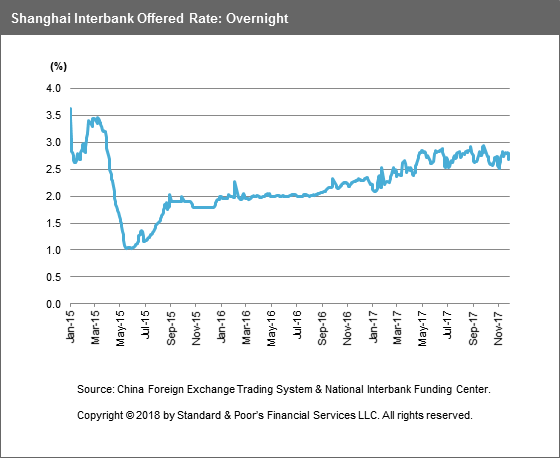
Unemployment rate
According to China's Ministry of Human Resources and Social Security, the unemployment rate in China has been stable over the past decade, even during the global financial crisis (see chart 7). The registered urban unemployment rate was 4% as of 2016, representing 9.82 million of urban residents who were registered to receive unemployment benefits. Although the unemployment rate has long been low, the figures do not take all jobless Chinese residents into account or include the number of migrant workers either, which stand for the major labor force in China. Besides, the unemployment rate of different districts may diverge, considering China's vast territory and industrial segregation in different areas.
Chart 7
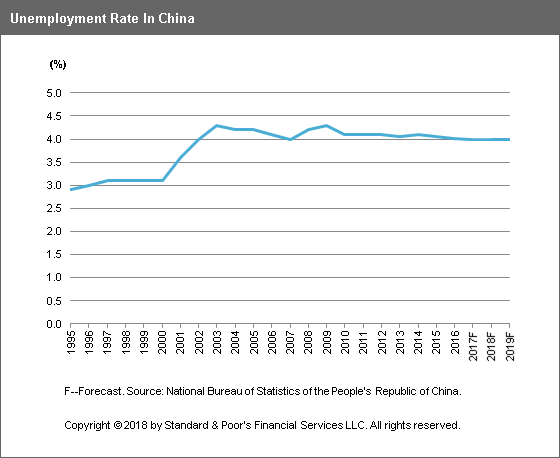
Disposable income and household debt
To promote a more balanced economic structure with stronger private-sector consumption, China is adopting reforms to push up the income level (even at the expense of industry competitiveness), enhance protection to labor, encourage new financing products, allow growth in household debt for housing and durable goods acquisition, among other things. In conjunction with continued GDP growth, stable inflation, and low unemployment, these reforms form a solid base for the growth of consumption and retail financing.
The low leverage and increased incomes of Chinese households continued to support debt serviceability. Household income increases with economic growth and more householders are now in a better position to make lifestyle choices. China's disposable income per capita in urban areas has more than doubled from 2008 to 2016 (see chart 8). In terms of household debt, China's household leverage as a proportion of GDP has also more than doubled to around 44% over the same period, according to BIS. This has given rise to some vulnerable households who have too much debt relative to their incomes. However, on aggregate it is still low compared with almost all advanced countries (see chart 9). This suggests the potential of further debt growth for further consumption.
Chart 8
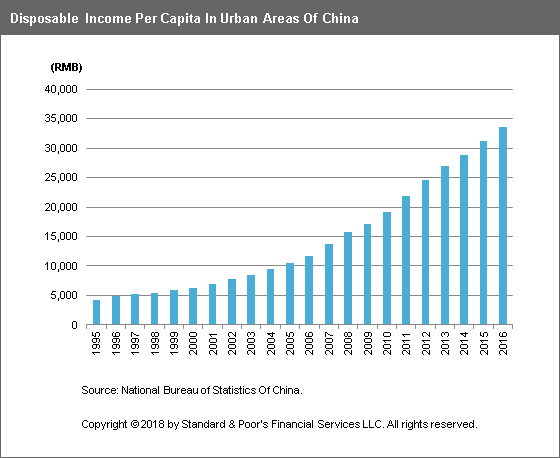
Chart 9
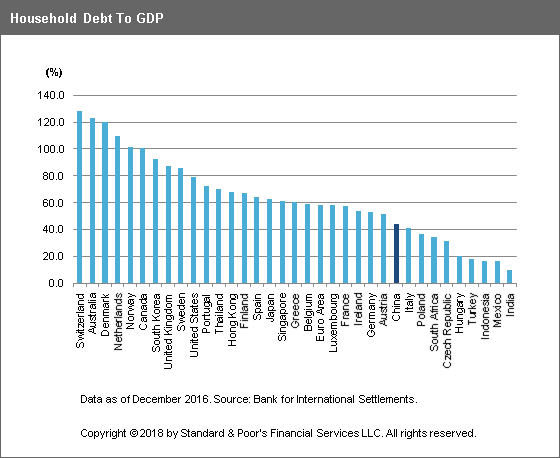
The Auto Market In China
Current market condition
China has become the world's largest new-car sales market since 2009. According to China Association of Automobile Manufacturers, automobile sales increased by 4.13% year on year to 22.9 million units in the first ten months of 2017. Sales of passenger vehicles in China grew by 2.1% year on year, to 19.5 million units at the same time.
By the end of June 2017, there were 328 million licensed car drivers in China, which is 76.3% more than that five years ago. Demand for automobiles has grown in line with incomes, and has been fueled by better affordability, the pursuit of a better quality of life, the construction of transportation infrastructure, and policy stimulus measures to promote car ownership. Such measures include the encouragement of automobile sales in rural areas, sales tax waiver for qualified new energy vehicles, and subsidies for the disposal of automobiles and purchase of more fuel-efficient vehicles. A purchase tax cut on small engine passenger vehicles to 5%, from 10%, stimulated sales in 2016. That tax rate was revised to 7.5% in 2017.
About 100 brands compete for sales in China's fragmented automobile market. The top ten passenger car manufacturers accounted for 57% of aggregate unit sales as of Oct. 30, 2017. Shanghai Volkswagen, FAW-Volkswagen, and Shanghai GM are the three largest passenger car manufacturers in China. As of October 2017, each had a market share above 8% (see chart 10).
Chart 10
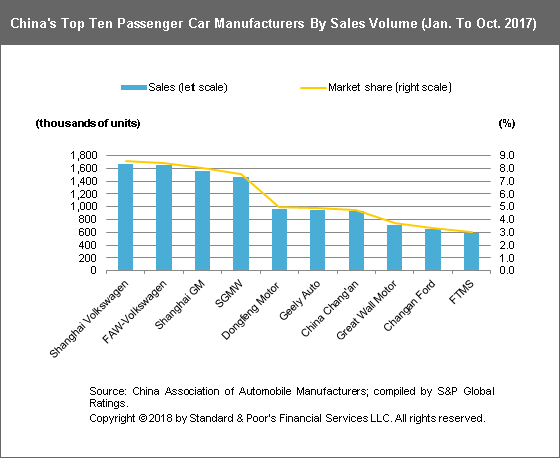
Major trends
Rising SUV sales change market dynamics. In terms of sales of passenger cars, the sedan remains the main type purchased, but its sales volume had largely stalled even with increasing market size over the past few years. Sports utility vehicle (SUV) sales are catching up quickly with a compound annual growth rate (CAGR) of 44.38% from 2013 to 2016 (see chart 11). This market dynamic affects the market share of car manufacturers, especially some Chinese companies that produce popular SUV models. Buyers' demand for more space, consumption upgrade, and relatively low fuel prices may be the major drivers of this trend.
Chart 11
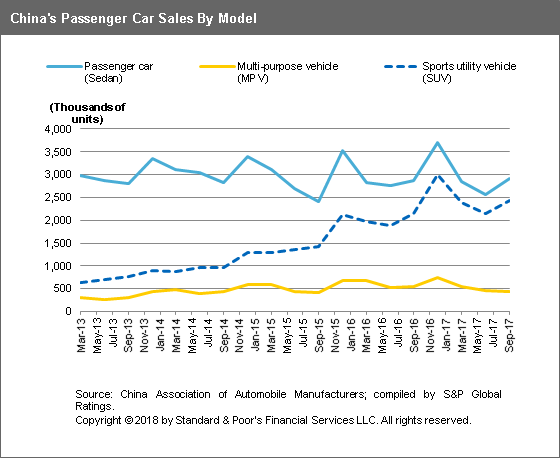
Small-engine passenger vehicles benefit from tax policy. Small-engine passenger vehicles (those with engine displacement smaller than 1.6 liter) have been the best sellers in China over the past few years, accounting for more than 70% of new car sales in 2016. The purchase tax cut benefit for the purchase of small-engine passenger vehicles, which became effective in October 2015, contributed to the surge of sales (see chart 12). However, sales for this vehicle sector slowed quickly in 2017, partly due to the less favorable tax treatment that became effective the same year.
Chart 12
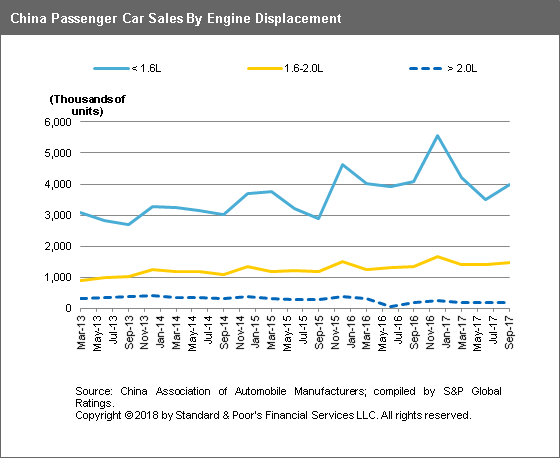
Sales of new energy cars is rising due to policy support. New energy cars, defined as vehicles using non-petrochemical fuel or hybrid-energy technology, have been a constant policy focus for China's auto manufacturing and sales due to the lower entry barrier for the country's auto industry development and the intention to contain air pollution. This sector currently has a very small sales base with very fragmented supply sources. According to local news reports, in 2015 more than 3000 new energy car models were available in the market, but only 77 of them have more than 1000 units produced. Thanks to the government's continuous support, new energy car production and sales have experienced rapid growth in recent years. According to China Association of Automobile Manufacturers, from January to November 2017, the number of new energy automobile production and sales were 639,000 and 609,000 units, respectively, growing by 49.7% and 51.4% year on year; electric passenger cars, with 504,000 vehicles sold and a 56.6% year-on-year growth, represented more than 80% of sales in this sector in 2017. The 2017 stimuli program rolled out by the Chinese government provides RMB20,000-RMB44,000 subsidy for each qualified electric powered passenger cars produced. Hybrid passenger vehicles manufacturer will get RMB 24,000 subsidy for each vehicle if the mileage range per charge is longer than 500 km. For vehicle purchasers, the government offers exemption for purchase tax, and vehicle and vessel tax. These policies may have a follow-on effect on the industry in the future, but the size of this sector remains small when compared with annual vehicle sales in China.
The used car market is growing. Car buyers in China had preferred to buy new vehicles due to the cars' relatively low acquisition cost, less transparent secondhand car prices and vehicle conditions, and complications related to moving a vehicle from one province to another in China. However, the secondhand car market has grown quickly in recent years. Used cars' turnover in China has reached 10 million units in the first 10 months of 2017 with a year-on-year growth of 21.8%. According to China Auto Dealers Association, in 2016 the sales of pre-owned passenger cars by third-party merchants or market places reached 7.7 million, or 24% of all passenger cars (new and used cars) sold. The increase in pre-owned cars sales could be attributed to the development of specialized used car dealers and sales platforms. However, some major hurdles remain for the development of pre-owned vehicles sales. Many provinces still restrict the registration of used cars shipped from other provinces by setting eligible criteria such as engine displacement, service life, and vehicle type, though they are slowly easing this constraint. Anti-pollution policies also may prevent some less efficient vehicles from reentering the market. These have lowered appetite for some vehicle models, and limited market-wide sales volume.
Car ownership
We believe economic growth and consumer confidence are among the key drivers of cyclicality for auto and commercial vehicle sales. Consumer confidence is critical because cars are a big-ticket item for most households. Global experience suggests that demand for passenger vehicles is also shaped by employment growth, households' income growth, household formation, interest rates, the availability of credit, and consumer-driven demands. In China, these factors are all sensitive to the economic conditions.
The pace of growth in automobile sales in China has been rapid against a formerly low level of stock and low base of penetration. According to China's Ministry of Public Security, as of June 30, 2017, Chinese residents own more than 205 million cars, which is 70% more than five years ago. There is still great upside potential for demand, given that car ownership is only 14%-15%, representing around 140-150 automobiles per 1000 people. In developed economies, the number is generally much higher.
Factors that limit car ownership growth in China are mainly the car sales restrictions in almost all first-tier cities and some second-tier cities due to traffic congestion and pollution prevention. Local governments manage this through limiting the issuance of car plates. The major growth of new car sales, therefore, may be switched to upgrade needs in the major cities, and unmet demand from residents in smaller cities. This trend may lead to a potential deterioration of auto loan borrowers' credit quality in the future due to potentially higher loan amounts and larger exposure to borrowers in economically less developed regions.
The interplay between government policy and the auto market
The Chinese government is a strong advocate for having a globally competitive domestic auto industry. The auto industry in China has become one of the mainstays of the economy, with great contribution to economic growth, employment, and stimulating domestic demand. Government initiatives could affect demand for particular brands and technology. For instance, policies have been in place to support domestic auto companies, including the provision of subsidies for research and development, funding support from state-owned banks, and procurements from the government. The antitrust investigations and fines on some auto parts manufacturers could also change the landscape of car pricing and parts suppliers.
Market outlook
S&P Global Ratings expects 2%-4% growth annually for China's new vehicles sales in 2017-2019. Part of this is due to a high base effect on the expiry of tax-based incentive for smaller-engine vehicles. We believe mild sales growth will continue due to the ongoing increase in household income, increasing penetration of financed automobile purchase, and the upcoming release of more car models customized for Chinese consumers. That said, market competition may also increase as a result of a more active pricing strategy and more available models from various manufacturers. New energy cars may gain greater share and become more competitive in the longer term, under the premise of better infrastructure support, technology development, improving product quality, and decreasing production costs. In addition to the expectation of increasing car ownership, we believe replacement and upgrade demand in major cities will become another key factor for passenger vehicle sales growth.
The Auto Finance Market In China
Financed purchase
Auto finance in China can be in the form of loans or leases provided by commercial banks, auto finance companies, and other financing companies, which are extended to retail/institutional vehicle buyers and auto dealers. The development of auto finance in China goes hand in hand with the expansion of China's automobile market (see chart 13).
Chart 13

China's auto financing business started in the late 1990s. Commercial banks provided most of the auto loans at the early stage, before auto finance companies entered the market in 2004. By the end of June 2017, almost every major commercial bank and a total of 25 specialized auto finance companies were providing auto finance in China. Most auto finance companies are manufacturer-captive finance companies.
Auto loan penetration is low but growing. Financed purchase is gradually making itself an indispensable part of automobile purchase in China. Fast growing car sales, change of consumer attitudes toward financed purchases, and increased variety of auto loan products all contributed to the rapid expansion of the auto loan market. According to market participants, about 35% of car purchases in China were financed through auto loans or other financing contracts in 2017, though the penetration of automobile financing could differ by brands, car sectors, and regions. Compared with the financing penetration rate in more mature markets, Chinese customers' use of financing remains limited. A Federal Reserve Bank report indicated that some two-thirds of new or used vehicle purchases in the U.S. in 2015 were financed. In Europe, that figure is approximately 60%. These experiences suggest further growth potential of the industry in China.
Major financiers in China's auto finance market
Auto finance companies (AFCs) and commercial banks are two major players in China's auto loan market. Other auto financiers, such as leasing companies managed by Ministry of Commerce, consumer money lenders, and micro-loan providers, only represented a small portion of the industry.
Auto finance companies. Currently there are 25 AFCs registered with China Banking Regulatory Commission (CBRC). These companies provide retail auto loans, dealer financing, and auto lease financing. Retail auto loans have gradually become the primary business for AFCs, accounting for 82% of their outstanding loan portfolio at the end of 2016, according to the China Banking Association, compared with 33% in 2005. The expansion of the retail auto loan business follows the rapid growth in auto sales and increased penetration of automobile finance. The outstanding retail auto loan receivables held by AFCs reached RMB426.5 billion at the end of 2016, 40% up from 2015.
Most manufacturer-captive finance companies only support the financing of their own brands. This has reduced competition at the level of auto finance companies. Competition however may come from banks and other market players such as consumer finance companies and lease companies. AFCs' main competitive advantage is their control of the dealership channels and the resulting customer accessibility. This is because the dealers are usually the first contact points for people looking for vehicle purchases. Their more intimate knowledge of the vehicles and vehicles purchases they finance helps maintain their underwriting quality, and enables them to extend their loan coverage to the purchase of value-added auto parts and services. Another advantage of AFC is the alignment of interest with the manufacturer. For sales stimulation purpose, manufacturers often subsidize their captive finance companies to offer more attractive low-interest rate loans to the customers.
The main disadvantages of AFCs are their relatively high cost of funds and limited funding sources, when compared with banks. AFCs in China cannot take retail deposits. The Management Guideline on Automotive Finance Companies lists the following funding alternatives for auto finance companies: deposits from shareholders, financial debentures issuance, interbank call loans, borrowing from financial institutions, and the sale of receivables (including ABS). Most auto finance companies still rely on bank loans and paid-in capital to get funding to support business, which lifted their funding cost and limited their ability to offer auto loan products with competitive interest rate. Specifically, the 8% minimum capital adequacy ratio applied on AFCs put a capital-based cap on their balance sheet growth, which indirectly limits the borrowing capacity and loan origination. These in turn limit the business growth potential for AFCs in China unless the shareholders can keep injecting capital.
For capital market funding, AFCs need to demonstrate stable performance results, especially profitability, before they can issue financial debentures. This, however, may take years for a newly set up company. Auto loan securitization, on the other hand, provides existing AFCs with a new channel to get funding with asset sale, which may also limit the balance sheet growth and resulting capital injection issues.
Auto loan asset quality between AFCs and banks can be different, which is mainly because of a different focus on underwriting, and varying extent of access to potential customers. Market participants believe that AFCs' underwriting is based on a more intimate knowledge of the vehicles they finance. AFCs also have better access to potential customers because dealers can present a vehicle price and financial proposal when a customer decides to buy.
Commercial banks. Commercial banks reach potential car loan customers at a later stage, but their services are not constrained by specific vehicles manufacturers--they can finance any brands. As traditional retail finance providers, banks typically have lower funding costs, widespread physical branches, and more standardized origination and underwriting practices. Banks look more into the customer's creditworthiness to assess the credit quality, rather than rely on knowledge of the financed vehicles. They are able to do so because they may have a more comprehensive transaction relationship with borrowers.
There are two main types of auto finance that banks provide--retail auto loans and credit card instalments. Funding cost advantage enables banks to provide more price-competitive auto finance product, but banks usually have higher down payment requirement on the loans. This is probably because of a more stringent risk management requirement, and that banks may not obtain the same in-depth information about the financed vehicles as AFCs do.
Other financiers. Unlike AFCs and commercial banks, most other auto financiers are not regulated by PBOC or CBRC. As a result, these financiers' loan operations are not necessarily bound by regulations as "Management Guideline on Automotive Finance Companies" and "Auto Loans Management Guideline." Financiers therefore have a more liberal product strategy, more creative origination and underwriting practices, and greater flexibility in choosing customers. At the moment, these financiers only represent a small portion of the whole auto finance industry, but their presence may eventually affect the auto finance market in terms of lenders' risk appetite, loan product innovation, loan pricing, and underwriting skills and techniques.
Table 3
| Comparison Between Major Financiers In China Retail Auto Loans | |||
|---|---|---|---|
| AFCs | Banks | Other financiers | |
| Relationship with vehicle make | Most AFCs are manufacturer-captive finance companies, and primarily support its own manufacturer-made vehicles. Manufacturers can provide a subsidy to AFCs for product offerings. | Typically not linked with specific manufacturers | Typically not linked with specific manufacturers |
| Auto finance products | Auto loans, leases | Auto loans, credit card instalment | Auto loans, leases |
| Primary origination channels | Vehicle dealers | Branches, online channel | Branches, online channel |
| Funding | Capital and wholesale funding only, no retail funding sources | Various funding sources | Capital and wholesale funding only, no retail funding sources |
| Advantage in underwriting | More intimate knowledge of the vehicles they finance | Has a more comprehensive understanding of a client's credit profile | More flexible origination, credit risk review, and collection process. Big data, social media data, and various FinTech tools may be utilized |
| Regulator | CBRC | CBRC | Ministry of Commerce or regional governments |
Relatively stringent regulatory oversight
The PBOC's and CBRC's regulations and ongoing oversight have supported the development of the auto finance industry in China and provided stability to the performance of auto financing. For a country that has explored auto finance for only a few years, the relatively stringent regulations and management are credit positives for auto loan and auto loan ABS, in our view.
The CBRC has set out the risk-management and financial strength requirements for auto financiers in its "Management Guideline on Automotive Finance Companies." Its counterpart, the "Auto Loans Management Guideline," issued by the PBOC and CBRC, facilitates credit checks and loan underwriting practices. The two guidelines are the most important regulations on auto loan origination in China.
Auto loan underwriting standards are regulated in China. The "Auto Loans Management Guideline" sets minimum requirements on auto loans extended to individuals, dealers, and other institutional borrowers. For example, an eligible borrower must have a good credit history and be able to demonstrate a stable income or assets to support a downpayment and the ongoing servicing of a loan, according to the guideline. This requirement essentially rules out nonconforming or subprime loans. Auto loans in China can only be extended for a maximum of five years and require a loan-to-value (LTV) ratio of up to 80%, except for defined new energy cars, and 70% for a preowned vehicle. There is continuous revision of the guidelines and in the near future we could see more deregulation, such as more flexible LTV ratios and vehicle mortgages arrangements, but there is an ongoing regulatory intention of keeping the market risk at a low level. In November 2017, the PBOC and CBRC jointly announced the amended "Auto Loans Management Guideline" (new guideline). The new guideline took effect from Jan. 1, 2018, and replaced the one that was introduced in 2004. The new guideline provides more flexibility over mortgage requirement if the lenders believe the borrowers have good credit quality and debt serviceability. The market response to the updated guidelines and the resulting industry dynamics will take time to form.
The "Management Guideline on Automotive Finance Companies" sets business scope, risk management, and the AFC's set-up and termination requirements. The regulation lists the financial services that AFCs are allowed to provide, and the funding channels that AFCs can utilize. Operations-wise, AFCs are also required to comply with the CBRC's internal control and risk management guidance to establish an effective risk-management system.
China regulators closely monitor the market and issue administrative guidelines from time to time. In January 2008, in response to heightened defaults of auto loans in the banking sector, the CBRC announced an administrative guideline on auto loan risk and asked financial institutions to enhance their measures on fraud prevention, document validation, credit checks, and collection management. The PBOC in recent years also intervened in the market, demanding slower loan growth and enhanced enterprise risk management.
Increasingly sophisticated underwriting and risk management
Partly driven by the regulatory environment, financiers in China recently have put more effort into risk-management skills and prudent underwriting. Based on S&P Global Ratings' observations, these financiers have:
- Centralized their credit decisions that are independent from business development and origination functions to ensure the consistent application of company-level underwriting policies and prevention of conflict of interest;
- Become more proficient in using the nationwide obligor credit information database and identity-check systems for fraud prevention;
- Increasingly utilized a quantitative credit-scoring system to supplement the credit decision process or used automatic approval/rejection;
- Established backward testing procedures to assess loan performance against previous credit decisions and scoring systems;
- Enhanced their risk-management capacity to cover credit risk and operation risk control; and
- Introduced new tools and risk review practices to assess the industry dynamics brought about by rapid loan growth.
These efforts are reflected in the performance of loans. The default rate of banks' auto loans was in the high single digits before 2008, but has remained around 1% since 2009. Auto finance companies meanwhile have been able to maintain severe loan delinquency rates below 0.50% for years.
Characteristics of auto loan products in China
Loan purpose. The majority of retail auto loan products in China are for new car purchases, though used car loans are growing fast due to the increasing participation of AFCs, finance lease companies, and used-car e-commerce platforms. There are also auto loan products to address specific needs, such as vehicles upgrades--a customer's used car can be traded in when acquiring a new car. Add-on loan products, which intend to meet vehicle owners' financing needs for vehicle maintenance, insurance, or trim upgrades, recently have increased in popularity. Lease contracts are also gaining in popularity, especially in non-CBRC regulated financiers.
Loan terms. Regulations provide for a maximum 60-month tenor for auto loan products in China. In practice, the vast majority of loan products are 18-36 months.
Down payment and LTV ratio. Chinese regulations set up specific LTV ratio limits in traditional auto loans (no more than 80% for new passenger car purchase, 85% for new-energy passenger cars, and 70% for used cars), but regulators are considering a more flexible LTV limit management due to a market need for more loan variety. The LTV ratio for a typical auto loan in China is currently around 60%.
Repayment method. Equal monthly repayment, in the form of level payment that includes principal and interest components or equal principle repayment in zero-interest loans, is the most common repayment arrangement in China's auto loan market. Balloon and more structured repayment methods have been introduced in loan products to target borrowers with different preferences. For such loans, the loan tenors are shorter and the down payment ratio tends to be high for the financiers to control the credit risk. Prepayment is generally allowed, though it can be subject to prepayment penalties, especially for loans seasoned less than a year.
Interest rate. Auto loan products can be offered with variable rates, with the rate to be reset by the lenders if they feel it is necessary; floating rate, based on the PBOC lending rate, or fixed rate. Either due to higher funding costs or perceived comparatively greater credit risk, auto loan interest rates are generally higher than residential mortgage rates, but lower than unsecured consumer lending such as credit card receivables. The effective interest rate could settle at around 10%, depending on lenders' marketing strategies and subvention from manufacturers. Unlike other markets, auto loan borrowers in China have a low sensitivity to a change in interest rates. This is because of a limited change in monthly payments even when rates rise, as a result of generally small loan sizes (most loans are lower than RMB100,000) and monthly amortization.
Less established preowned car market and foreclosure process limit loans' recovery after defaults. Despite its rapid development, the secondhand car market remains less organized and the function of fair vehicle pricing is still developing. For instance, according to market data disclosed by China Automobile Dealers Association, more than 75% of preowned cars offered in the market are more than three years old, while most vehicles repossessed due to loan defaults are within three years due to loan tenor designs.
Other than the difficulty in finding fair vehicle prices for mortgaged cars, the foreclosure process and timing of vehicle repossessions and auctions after loan defaults is less certain. We are uncertain about the legal system's capacity to handle loan defaults and the effort needed to locate the vehicles. As a result, auto loan recovery rates in China tend to be more volatile and lower compared with more established markets. The number can range from less than 10% to around 40% among different financiers and time periods.
Comparison between U.S., Europe, and China auto finance markets.
- The auto loan products offered in China usually have a shorter term than U.S. loans. Auto loans in China usually have a term of 18-36 months, with the longest not exceeding 60 months (capped by Chinese regulators). The term is usually 72 months in the U.S. auto finance market, and a greater percentage of U.S. loans are now up to 84 months in tenor.
- The LTV ratios for auto loans in China are much lower. An LTV ratio of around 60% on average is applied to China's auto loans. The LTV ratios of many U.S. auto loans are at or near 100%, and subprime auto loans typically have LTVs well above 100%. In Europe, the LTV ratio for auto loans is usually 80%-85%.
- Borrowers usually must maintain an account with a designated Chinese bank for loan repayments, and payments are typically made by direct debit. This is not nearly as common for U.S. auto loans, but does happen with Canadian auto issuance. In Europe, direct debit is also the standard way of collecting installments, while there is no requirement to have an account with a large bank.
- Regulators in China do not allow the origination of nonprime or nonconforming auto loans. These two types of loans are allowed in the U.S. Europe doesn't have a subprime market, though this is not due to regulatory constraints.
- The severe delinquency rates of auto loans supporting auto loan ABS in China have been as low as 0.2%-1.0%, which is lower than in the U.S. Car loans more than 90 days in arrears in Europe are at around 0.15%.
- Recovery assumptions are generally much lower in China due to the different legal procedures around repossession and less market liquidity for secondhand cars. Observed recoveries in Europe are typically meaningful, but also depend on country/jurisdiction.
Table 4
| Comparison Of Retail Auto Loan Characteristics In The Chinese, U.S., And European Markets | |||
|---|---|---|---|
| China | U.S. | Europe | |
| Typical tenor | 18-36 months | 72-84 months | 36-48 months |
| Loan-to-value ratio | 60% on average | Around 100%; subprime is more than 100% | Usually 80%-85% |
| Payment collection | Typically direct debit | Direct debit is not common | Typically direct debit |
| Eligible borrower | Prime only | Prime, subprime, and nonconforming | No subprime market |
| Severe delinquency | 0.2%-1.0% | More severe than that in the Chinese market | Around 0.15% |
Overall, the terms of China's auto loans appear to be more conservative than their global counterparts due to market conditions and regulatory requirements. That said, we note that China's auto finance sector is relatively new and still evolving. New players, especially those not constrained by CBRC regulations, could enter and underwriting practices could change.
Leasing market
Market participants are exploring alternatives to traditional auto loan products in the auto finance market, such as operating leases and finance leases. The current penetration of leasing is low in China's auto market. The low base in China provides more room for growth, and the market is attracting an increasing number of participants, including existing finance lease companies, auto finance companies, manufacturers, and auto dealers. Auto dealers, for instance, have started setting up lease businesses to expand the scope of their business to cope with the slowdown in car sales growth. Providing finance leases to potential buyers also helps auto dealers to raise their sales and bring down inventory.
Challenges and prospects for the auto finance business
China's fast-growing auto finance business faces challenges. Continuous growth can only be achieved through further penetration into lower-tier cities, which could raise concern over potential deterioration of loan quality due to less resilient economic conditions in such cities. Lenders' underwriting skills will become crucial to maintain portfolio asset quality amid such expansion. Also, the availability of funding and its sustainability will continue to be a primary concern for nonbank auto finance institutions.
The growth prospects for auto finance are certain, despite these challenges. Government policies, technology development, and the market potential of further retail penetration and dealership financing support our view.
Chinese regulators have been supportive of the development of the consumer finance industry, with a policy backdrop of economic rebalancing to private consumption. In March 2016, the PBOC and CBRC collectively released their "Guidance on Enhancing Support to New Consumer Finance," which allows auto finance companies to finance accessorial products or services related to vehicle ownership. The recently announced change to the management guidelines on auto finance also provides more flexibility over car loans' LTV ratios and mortgage requirements. Regulations also encourage new funding sources for auto finance companies, such as securitization, bond issuance, and interbank borrowing.
Continued technology innovation is also helping financiers' underwriting and customer acquisition. For instance, borrowers' credit information now can be retrieved and analyzed through more sources and in a more efficient way with the support of information technology. This can improve financiers' ability to construct a better credit profile of consumers and enhance loan underwriting efficiency. Loan products such as "one-hour loans" that aim to shorten the processing time for loan applications are now possible as a result.
The still-low penetration rate of retail auto finance and the growth in vehicle sales have provided a strong base for business growth in pure loans and other financing products, such as leases. The expansion to preowned car financing is happening as well. In addition, the increasing reception of add-on financing to support vehicle ownership, including financing to support trim upgrades, maintenance, and insurance, provides room for business development. The need for dealership inventory financing has not been fully addressed in China, in our view, and could introduce another source of financing business. The nature of risk and operation in these wholesale businesses could be quite different from the retail sector, however.
Auto Loan Securitization In China
Primer on securitization in China
Securitization started in China in 2005, when two banks respectively issued two transactions with collateral of residential mortgages and corporate loans. A series of trial deals were then issued to finance a variety of assets until the global financial crisis in 2008, when all issuance shut down.
The PBOC and CBRC in 2012 reopened their credit asset securitization pilot program and expanded it to encompass more economic sectors. The China Securities Regulatory Commission (CSRC) also reopened its securitization program for corporate assets, with asset securitization business guidelines in place for securities firms. In 2013, the State Council announced plans for the normalization of securitization in China and encouraged financial institutions to actively manage their balance sheets and asset stocks. The Third Plenum of the 18th Central Committee of the Chinese Communist Party in November 2013 called for the establishment of a sound securitization market.
At this moment there are three major securitization schemes in China managed by different regulators in accordance with respective regulations: the Credit Asset Securitization (CAS) scheme, managed by the CBRC and PBOC; the asset securitization program scheme, managed by the CSRC; and the asset-backed notes program managed by the National Association of Financial Market Institutional Investors. The demand for securitization rose quickly after 2012, and S&P Global Ratings statistics indicated that China is now the world's second largest securitization market in terms of new issuance volume (see chart 14).
Chart 14
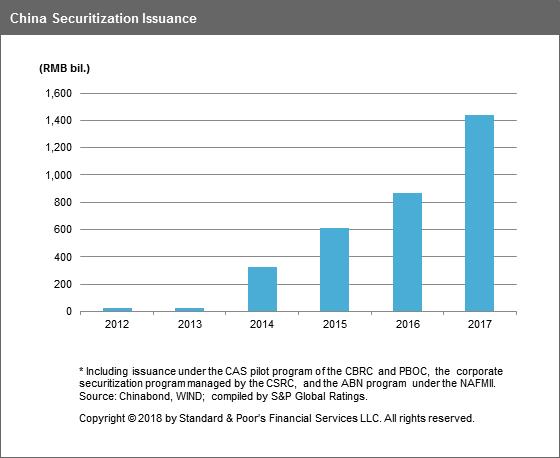
Among the different securitization schemes, the CAS program is the most used platform for auto loan ABS issuance. Transactions using this scheme fit the traditional understanding of asset securitization, with asset segregation from the originators/sellers to prevent their failure from affecting the cash flow of securitization transactions, and the bankruptcy remoteness of issuers.
We also see securitization issuance backed by auto lease or auto-related loans in the securitization scheme managed by the CSRC. The issuance amounts of these transactions are typically lower than that of transactions under the CAS program, and the issuers are limited to couple of auto lease companies.
Asset segregation and issuer bankruptcy remoteness are based on existing legislation. The CBRC and PBOC launched the CAS pilot program in 2005, when administrative guidelines on securitization origination, structuring, issuance, marketing and listing, and information disclosure went into effect. The authorities oversee securitization issuance through a registration and approval process that provides regulatory and legal certainty to the transactions. While the guidelines have been amended since their implementation, the pillars of the securitization infrastructure--the use of special-purpose trusts (SPTs) as the issuing structure and the entrustment/true sale of assets to facilitate asset segregation from the sellers--remain unchanged.
There are no specialized securitization laws in China, unlike nearby markets such as Japan, South Korea, and Taiwan, which started securitization with official legislation. S&P Global Ratings' analysis suggests that specialized securitization laws typically have significant ties with other general laws. In some civil-law markets in Asia, for example, special-purpose vehicle legislation or trust laws usually establish the bankruptcy remoteness of the issuer, with reference to corporate or bankruptcy laws. For an asset's true sale, securitization laws generally tie in with trust, trade, contract, and pledge laws, as well as specialized asset management guidelines and laws for assets transferability and perfection procedures.
Absent specialized legislation, the CBRC and PBOC's securitization regulations use China's Trust Law (2001), Contract Law (1999), and Pledge Law (1995) as the basis of issuers' bankruptcy remoteness and the segregation of assets from the sellers.
The assets that can be securitized through special purpose trust (SPT) structures are stipulated in the related guidelines under the PBOC and CBRC's CAS pilot program. We believe the securitized assets are eligible to be transferred through the trust structure pursuant to the CAS regulations because the transaction needs to be registered with the CBRC and PBOC. This assurance, coupled with the linkage of the CAS program to the Trust Law, supports our view that the SPT will be protected by the Trust Law, and the entrusted assets will be segregated from the originators.
Typical transaction structure of auto loan ABS in China
A typical auto loan ABS will involve an originator, either an AFC or a bank, selling a pool of auto loans receivables to a SPT, which is set up by a trust company (the trustee) for the purpose of securitization. To fund such receivables purchase, the trustee will issue (on behalf of the SPT) different classes of trust certificates to investors.
The collateralized assets are loans extended to retail borrowers, used to finance the purchase of cars. These loans have original terms of up to 60 months, but remaining terms are typically within 36 months. Initial LTV ratios range from 50% to 80%. Vehicles purchased through these loans are mortgaged for the benefit of the originator.
The asset pool could be static (no assets substitution or reinvestment is allowed) or revolving. Collections--inclusive of interest, principal, penalties, and any other payments--from the assets will be used to pay down the principal of the securitization notes or to acquire new assets, after satisfying SPT taxes, senior expenses, and senior interest. Most transactions adopt a sequential turbo repayment structure using a single waterfall.
We typically see a cash liquidity reserve being set up and funded upon deal closing. The liquidity reserve provides liquidity support to the transaction's expenses and interest on rated notes, if needed. The originator will be the transaction's servicer to collect payments of the receivables and manage arrears. Chart 15 depicts the deal structure of a transaction related to Beijing Hyundai Auto Finance Co., which is typical in the market.
Chart 15
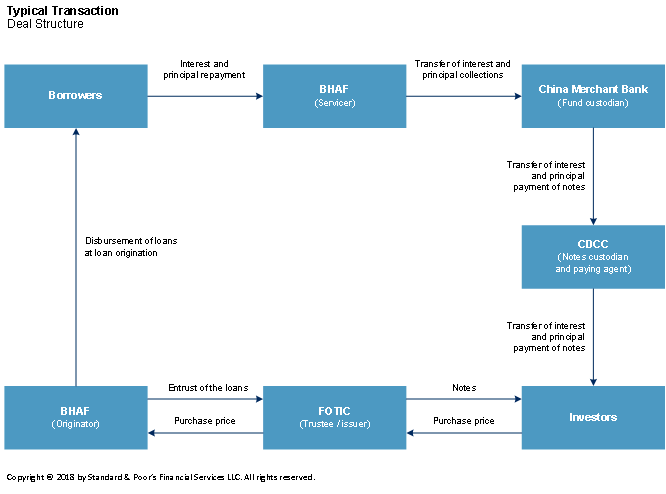
Regulatory support for auto loan securitization
The regulators' policy intention to better use capital market funds to support the country's general economic and financial market initiatives supports the development of securitization in China. Encouragement and support from regulators is essential in the auto loan securitization sector, in our opinion.
The CBRC and PBOC's decision to reopen the securitization market in 2012, and the subsequent supporting announcements from the State Council and Communist Party, demonstrated the policy role of securitization in China.
The PBOC has publicly stated the benefits of securitization to facilitate the Chinese government's financial policy, citing the use of securitization in adjusting the credit market structure, reducing capital needs for banks, constraining the expansion of banking books, increasing monetary efficiency, and enriching capital market offerings.
The introduction of more self-discipline initiatives in the market at the end of 2014 as part of efforts to enhance operational efficiency was an important milestone in China's securitization market. The new processes include the registration of intended issuance and transaction structures rather than the approval of individual transactions, and the inclusion of industry associations to coordinate issuance-eligibility reviews. Such deregulation signals that the regulators are ready for the market to lead its own development, ending a period of initial guidance, encouragement, and stringent oversight by the authorities. Transactions can now be launched within weeks of preparation, rather than the months it used to take, thanks to the simplified issuance registration process. The implications are significant. Auto loan ABS issuance in 2015 was more than twice that of 2014, and issuance in 2016 was up 50% from the previous year, according to Chinabond data. Issuers expand quickly; about half of the auto finance companies in China now have their own securitization programs.
Securitization as a regular funding channel for auto financiers
Most auto loan securitizations in China to date have been originated by auto finance companies related to various manufacturers. In the nine months ended September 2017, more than 95% of auto loan securitization volume came from AFC-sponsored transactions (see chart 16).
Chart 16

The distribution of issuers reflects the imminent funding needs of auto finance companies, which do not have retail deposit support. As an alternative funding channel, securitization issuance grew in line with the rapid development of the auto finance market and accumulation of experience in auto loan ABS. After limited issuance of about RMB2 million in each of 2008 and 2012, auto loan ABS issuance shot up to RMB16 billion in 2014 and RMB42 billion in 2015. Issuance growth slowed in 2016, though the aggregate offering easily surpassed that of 2015, reaching RMB59 billion (about US$9 billion-US$10 billion equivalent). This amount is around 15% of the total securitization volume, and the third-largest type of asset securitized under the CAS scheme in 2016. In the nine months ended September 2017, new issuance reached RMB72.3 billion. We attribute the strong growth to the repeated issuance from captive auto finance companies related to various manufacturers.
Chart 17
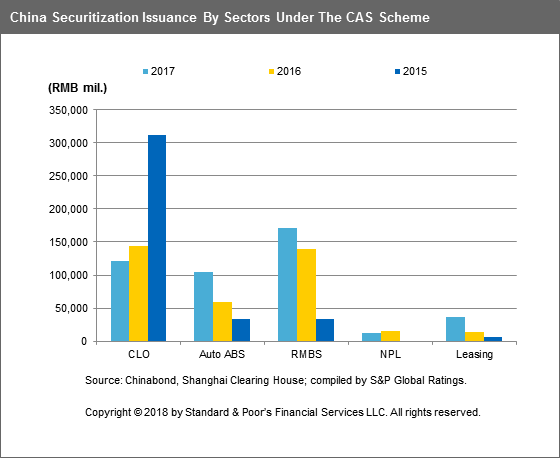
The issuance of new auto loan ABS transactions exceeded RMB211 billion between 2008 and October 2017. Among the 25 auto finance companies in China, 13 have issued at least one transaction and ten have issued at least two transactions. The repeated issuance suggests that securitization has become a regular part of financiers' funding strategies.
Chart 18
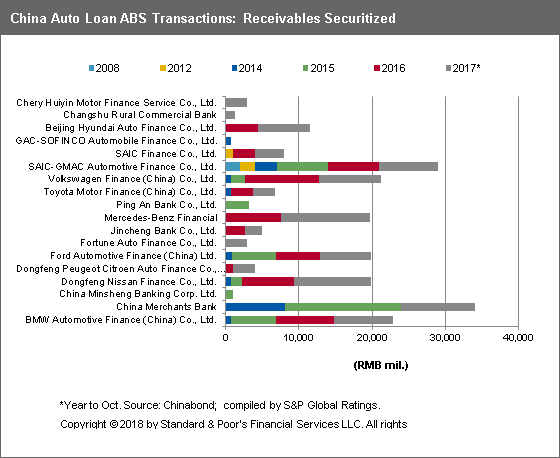
Moreover, the sale of auto loan receivables to special-purpose vehicles transfers entitlements as well as the related risk of the receivables to the trust and, ultimately, the noteholders. The true sale nature of asset securitization reduces risk accumulation in the originators. The idea of balance sheet and risk management through securitization goes beyond the auto finance companies. Five Chinese banks issued 11 auto-related receivables securitization between 2014 and October 2017, with an aggregate amount of RMB44 billion, which was about 22% of the total auto loan ABS issuance during this period.
China auto-loan ABS leverages global securitization experience. Many AFCs in China are affiliates of global operators such as General Motors, Nissan, Toyota, Ford, BMW, and Volkswagen. These global financiers have engaged in securitization transactions in recent years in the U.S., Europe, Japan, and Australia, and now leverage their experience in China. Based on our experience in these other markets and public information disclosed in the Chinese transactions, we believe most of the underwriting standards and structures in the deals in China are similar to those used by companies in other markets. An exception is product composition, which tends to be more conservative in China.
We believe that linking the local offerings with originators' global issuance practices has hastened the learning process in deal origination and structuring, making quick offerings possible. Investors also might have greater confidence over the performance of China auto-loan securitization because similar structures already have been tested in other markets. International investors meanwhile find it easier to analyze Chinese transactions because they are already familiar with the global peers.
Asset characteristics.
- Prime and diversified borrowers: China's auto loan ABS issues to date are backed only by borrowers classified as prime. In the U.S., there is around 42% of subprime issuance volume in the retail auto loan ABS market. In addition, the loan pools in China are with diversified borrowers and geographic distribution.
- Mostly backed by new vehicles: China's auto ABS deals are nearly all backed by new vehicles. In the U.S. and Europe, the deals generally contain a mix of new and used vehicle loans.
- Low LTV ratios and short tenors: Auto loan pools securitized in China usually have LTV ratios lower than 65%, which is relatively low compared with auto loan pools securitized in the U.S. and the European markets. Most auto loan receivables securitized in China are fully amortized, with level payment every month. Balloon or bullet contracts exist in some of the transactions, but with only a small percentage of the receivables amount. In general, the loans are seasoned, with maturities in the following two to three years. Shorter tenor is another observation in China's auto ABS transactions, compared with the U.S. and European transactions.
- Full-recourse loans: All contractual payments under the auto loan receivables are full-recourse obligations of the borrowers under Chinese law. As a result, a trust is less exposed to any market-value risk associated with the sale of motor vehicles (on performing receivables). This is a risk that could be associated with other products, such as operating leases. The full-recourse nature will not only reduce a borrower's intention to default, but also increase the recovery of defaulted loans because the SPT can go after the borrower's other assets for debt repayment.
Note characteristics.
- Simple payment structure and similar forms of credit enhancement: In China's auto ABS market, most deals are offered at RMB3 billion-RMB4 billion, with some exceptions. Most of the auto ABS issuance in China has adopted simple payment hierarchies, with two or three classes of notes issued. Most transactions repay notes in a sequential order from senior to junior notes. Pro-rata pay between senior and junior notes has been used, but is not common. The credit enhancement can come in the form of subordination, overcollateralization, and excess spread, all of which are commonly seen in other markets.
Table 5
| China Auto Loan ABS Deals (Year To October 2017) | ||||||||||||
|---|---|---|---|---|---|---|---|---|---|---|---|---|
| Deal name | Seller | Pricing date | Amount (issuance amount) (RMB bil.) | Coupon/yield (senior) (%) | Coupon/yield (class B) (%) | |||||||
| Jincheng 2017-1 | Jincheng Bank | 13-Jan-17 | 1.70 | 4.20/4.49 | 4.65 | |||||||
| Fortune 2017-1 | JAC Motors | 18-Jan-17 | 1.00 | 4.30 | 4.99 | |||||||
| Rongteng 2017-1 | SAIC-GMAC | 3-Mar-17 | 4.00 | 4.20 | N/A | |||||||
| SAIC 2017-1 | SAIC | 6-Mar-17 | 3.91 | 4.08/4.25 | N/A | |||||||
| Bavarian Sky China 2017-1 | BMW | 10-Apr-17 | 4.00 | 4.60 | 5.00 | |||||||
| Fuyuan 2017-1 | Ford | 13-Apr-17 | 2.00 | 4.57 | 5.00 | |||||||
| Silver Arrow China 2017-1 | Mercedes-Benz | 17-Apr-17 | 5.51 | 4.70 | N/A | |||||||
| VINZ 2017-1 | Dongfeng Nissan | 4-May-17 | 4.00 | 4.80/4.90 | N/A | |||||||
| Driver China six | Volkswagen | 9-May-17 | 4.48 | 5.05 | 5.50 | |||||||
| Toyota Glory 2017-1 | Toyota | 16-May-17 | 3.00 | 4.95 | 5.35 | |||||||
| Autopia China 2017-1 | Beijing Hyundai | 18-May-17 | 3.50 | 5.25 | 5.45 | |||||||
| Rongteng 2017-2 | SAIC-GMAC | 22-May-17 | 4.00 | 4.95/5.10 | 5.60 | |||||||
| Jincheng 2017-2 | Jincheng Bank | 20-Jul-17 | 0.59 | 4.83/5.24 | 5.60 | |||||||
| VINZ 2017-2 | Dongfeng Nissan | 3-Aug-17 | 3.00 | 4.74 | N/A | |||||||
| Bavarian Sky China 2017-2 | BMW | 8-Aug-17 | 4.00 | 4.74 | 4.94 | |||||||
| Fuyuan 2017-2 | Ford | 17-Aug-17 | 3.77 | 4.65 | 4.95 | |||||||
| Dongfeng Peugeot Citroen 2017-1 | Dongfeng Peugeot Citroen | 22-Aug-17 | 3.00 | 4.85 | N/A | |||||||
| Fortune 2017-2 | JAC Motors | 24-Aug-17 | 2.00 | 4.98 | 5.32 | |||||||
| Changxing 2017-1 | Changshu Rural Commercial Bank | 29-Aug-17 | 1.25 | 4.80/4.85 | 5.25 | |||||||
| Driver China seven | Volkswagen | 6-Sep-17 | 3.98 | 4.95 | 5.20 | |||||||
| Autopia China 2017-2 | Beijing Hyundai | 12-Sep-17 | 3.50 | 5.00 | 5.20 | |||||||
| Silver Arrow China 2017-2 | Mercedes-Benz | 19-Sep-17 | 5.24 | 4.90 | N/A | |||||||
| VINZ 2017-3 | Dongfeng Nissan | 12-Oct-17 | 3.50 | 4.81/4.85 | N/A | |||||||
| Hexin 2017-1 | China Merchant Bank | 16-Oct-17 | 10.50 | 4.98/4.99 | 5.40 | |||||||
| Chery Huiyin 2017-1 | Chery | 17-Oct-17 | 2.98 | 5.02 | N/A | |||||||
| Source: WIND, Chinabond. N/A—Not applicable. | ||||||||||||
- Short weighted-average life: At one to two years, the weighted-average life of outstanding auto-loan ABS in China has been relatively short compared with those issued in other markets. Due to the mostly sequential repayment structure and shorter asset lives, the outstanding securitization amount in the market has been much lower than the aggregate issuance. Rapid amortization shortens the time horizon of risk exposures and gives investors a chance to observe full-life deal performance, both of which are important for a new market. However, it invites criticism from investors because they face continued reinvestment risk, especially those who prefer a long investment horizon. As a result, investors might choose against looking into the market because the effort of researching the deal might be unjustified, given the short holding period.
- Mostly static pool transactions, revolving structure appeared recently: Most of the transactions are closed pools, which means that collections from the collateral pool are used to redeem notes as they are received. The first revolving structure transaction appeared in 2015. To date, only three transactions used a revolving structure, i.e., for a specialized period starting from the closing date (issue date), the collections from the collateral pool are used to purchase additional collateral. These transactions will start amortizing one year after the closing date, or by the time an early amortization event occurs, whichever is earlier. The appearance of revolving structure transactions reflects investors' demand for extended transaction lives, particularly when considering the short asset maturities in China auto loans.
Structure characteristics.
- Using special-purpose trusts to hold the securitized assets: The auto loan receivables are entrusted to the SPTs constituted under the Trust Law between the seller of the receivables and the trustee. Because an SPT is a trust and not a legal entity, the trustee of the trust issues notes and enters into various contractual agreements with transaction counterparties on behalf of the SPT. The contractual agreements contain the securitization structure, asset definitions, notes' terms and conditions, the management of the transaction, and the management of assets. This form of issuing structure is commonly seen in Australia, Japan, South Korea, and Taiwan.
- Commingling risk is actively managed: Most borrowers in China repay their auto loans using direct debit to the lender's account. In some cases, payments can be concentrated at particular times of the month. When a loan pool is securitized, the SPT relies on the servicer, which is often the seller, to collect loan proceeds and transfer them to the SPT account within an agreed timeframe. During this collection period, the SPT is exposed to the risk of asset collections being commingled with a servicer's cash. Under normal circumstances, the collections are identifiable through accounting and typically cause no transfer delays to the SPT. However, if a servicer were to go into bankruptcy while holding an SPT's collection, then the commingled fund could be caught up in the bankruptcy proceedings of the failing servicers and therefore delay the payments to the SPT. In China such commingling risk is commonly mitigated through a commingling reserve mechanism combined with advance payment collections from a servicer if its creditworthiness deteriorates. Some of these mitigants are widely adopted in other markets.
- Preparations to manage liquidity risk are in place: Auto loan ABS transactions in China typically combine the loan pool's interest and principal collections and apply them in the order of trust senior expenses, note interest, and principal payments. As a result, any mismatches between interest collections from the loan pool and note interest payments can be temporarily covered using principal collection (principal draw mechanisms). In some cases, surplus interest collections can be used to repay note principal (also known as principal turbo-payment) and create a further buildup of credit enhancement. Transactions also typically employ a cash reserve account that is sized at a certain percentage of pool balance--about 1.0%-1.5%--or is based on an absolute amount to cover two to four months of senior expenses and note interest payments. The reserves could be released to cover asset losses and repay note principal under particular circumstances. The principal drawn and the cash reserve mechanism create liquidity in the transaction to manage cash-flow interruption or mismatch risk.
Noteworthy legal features.
- Assignable receivables: Almost all auto loan contracts originated in China in recent years have clauses addressing the transferrable and assignable nature of the receivables, meaning that the originators can sell/transfer the contracts to third parties without the borrowers' consent. China's Contract Law also allows such an arrangement. Under Chinese laws, the transfer will not be effective against the borrowers if the originator does not notify the borrowers of the transfer. Without such notification, and even though the receivables have been legally acquired by the SPT, the borrowers' payments will continue to be made to the originator. A potential risk to this is that the borrowers might claim their set-off right against the SPT if they have other rights against the originators and the maturities of such rights are no later than the maturities of the loans. The issue could be more complicated if the originator is insolvent or stops the business, leaving no entities to issue the assignment notice and direction of payments. In transactions in other markets, where it is legally effective, we have seen the sellers issue a power of attorney to the security trustee to exercise the rights of the sellers under the loan agreements so that the security trustee can issue the notification upon a servicers' bankruptcy. In China the deal trustee can issue the notices to individual borrowers if the servicer does not do so, but we've yet to have any precedence for this.
- Registration of mortgage and the recovery: According to China's Pledge Law, mortgage rights are not separable from the auto loans they collateralize and cannot be transferred without the transfer of the loans. Under Chinese law, these mortgages cannot collateralize other debt as well. We therefore believe that when the originators transfer the loans to the SPT, the related mortgages will be automatically transferred. Vehicle mortgages for the collateralization of auto loans need to be registered with China's vehicle administration agency under the police department, with the originators as the beneficiaries. However, the originator will not change the mortgage beneficiary (to the trust) in China's mortgage registration system upon asset transfer. Pursuant to China's Property Law, the mortgage registration is not a precondition to effect a mortgage over automobiles, which shall be established upon execution of the mortgage loan agreement between mortgagor and mortgagee. As the related mortgages are automatically transferred to the issuer along with the transfer of the loans, even without reregistering the issuer as mortgagee, the issuer (as mortgagee) can still claim the mortgage rights against the borrowers. However, in the absence of the required mortgage registration, the mortgage right cannot be claimed against a bona fide third party. In particular instances, the lack of reregistration therefore could negatively affect the asset repossession process if the originator becomes insolvent and the loan borrower defaults. Based on this consideration, we have assumed low recovery for severe delinquent loans in the transactions we review.
Performance Of Auto Loan ABS In China
Correlation of default and economic condition
Unemployment and interest rates are typically the two macroeconomic factors that most affect the performance of auto loans in most countries. In China, however, we believe unemployment plays a larger role than interest rates. The effect of unemployment on a borrower's income and debt serviceability is a universal consideration when assessing loan performance. In contrast, the change in monthly payments if the loan interest rate is raised--a common risk in other auto-loan markets--would be contained in China, thanks to the generally smaller loan amounts and full-amortization features of auto loan products there.
In addition to unemployment rate and interest rate, the macroeconomic factors and industry parameters that we track in China for deal performance projection are economic growth, household debt burden, and increases in vehicle ownership and vehicle sales. These factors affect our base-case and stress-case assumptions for loan losses, particularly default frequency and recovery from borrowers or, to a lesser extent, vehicle repossessions.
Asset performance
Transaction performance, measured by assets' payment delinquency and pool payout speed, has been quite stable in auto loan ABS in China. The cumulative default rate generally is below 1.5% of initial pool balance of respective pool and the cumulative net loss rate is mostly below 1% (see charts 19 and 20). The severe payment delinquency rates in most securitization transactions are lower than those in the vintage pools--the mother pools of the originators--disclosed by originators. We believe this is probably due to stricter asset eligibility criteria and loan seasoning in securitization issuance.
Chart 19
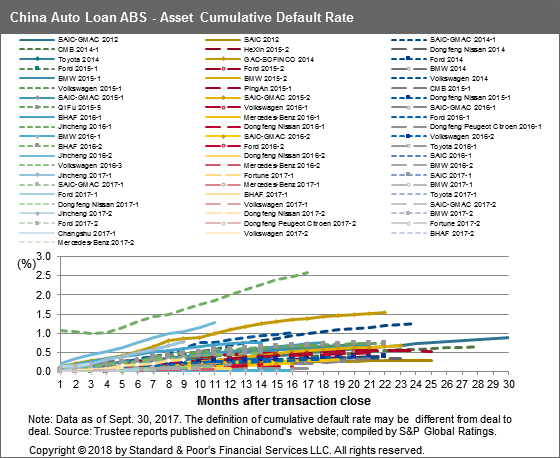
Chart 20
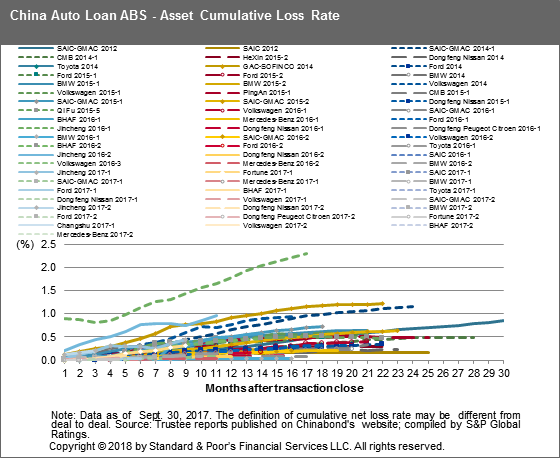
In terms of the pool payout speed, China's auto loan ABS are repaid sooner than those in other markets, thanks to the typically shorter-tenor assets, transactions' turbo repayment arrangements, and sequential pay-down structures. The senior tranche of issued notes typically have a duration of less than 18 months, and the mezzanine notes are usually fully redeemed within two years (see chart 21). The low loss rate, along with the quick payout ratio in portfolios, effectively limits investors' exposure to credit risks in China auto loans. In addition, short asset tenors and the buildup in credit support due to sequential repayment structures are strong mitigants against deterioration in economic conditions.
Chart 21

We believe some distinctive asset and structural features support stable deal performance in Chinese auto loan ABS. These include:
- The lower LTV ratios of securitized loans. This could discourage some borrowers from defaulting due to the faster accumulation of equity on the vehicles when loans amortize.
- Smaller loan amounts compared with household income.
- Shorter loan maturity (most transactions repay within 36 months). This limits the time that transactions could be exposed to adverse economic conditions.
- Highly diversified pool composition (single loan concentration rarely exceeds 0.1% of pool amount). Asset diversification could prevent borrower concentration in some industries or areas that are subject to higher volatility.
Also supporting loan performance is the regulatory oversight on auto financiers, and financiers' improving underwriting skills. The CBRC and PBOC employ stringent regulations and administration on loan terms and conditions, borrowers' eligibility, loan quality control, and risk management of auto financiers. S&P Global Ratings believes such regulatory oversight explains the generally sound performance of auto loans in China since 2009.
Most financiers in China now use a centralized and independent loan-review process, supported by rigorous information checks and document-verification processes, and in-house credit-scoring systems. In our view, these underwriting enhancements partly explain the continued improvement of loan performance for many financiers in recent years.
Expectations for robust auto loan ABS performance amid slowing economic growth
The slowdown in macroeconomic growth, effect of economic rebalancing, and pressure on business operations in some industries raise uncertainties over the future performance of auto loans. That said, we expect transaction performance to be robust in the next one to two years, thanks to the mild competition in the auto-loan industry and resultant stable product offering, and the structural arrangements of the transactions. In addition, Chinese households' relatively low debt leverage and increasing income levels will continue to provide support to loan performance as borrowers' debt serviceability strengthens.
The mild competition in the auto loan industry could be attributed to the relatively low penetration of auto financing, low rate of vehicle ownership, and the continued growth in passenger car sales during the past few years. This provides little incentive to auto financiers to loosen their underwriting quality to compete for business. Besides, most of the auto loan securitizations issued in China have been originated by captive auto finance companies and most of them only support the financing of their own brands. This has reduced competition among auto finance companies. However, competition and underwriting challenges could arise with the participation of nontraditional financiers, increased vehicle sales to second- or third-tier cities, and financiers entering the used car market. The performance of deals under economic stress should become clearer in the next few years, following more deal issuance and greater data history accumulated.
Future Market Development
We believe the auto loan securitization market still has great upside potential, with issuance volume continuing to build and more financiers' participating. Every percentage increase in auto loan penetration can create a considerable amount of new auto loan issuance in China due to the large new-car market there. The potential surge in auto loan businesses as well as financiers' more frequent utilization of securitization should contribute to a rise in auto loan ABS volume. We expect investors' confidence will continue to grow and that the market will continue to develop a greater variety of structures and assets. Our expectations are supported by the continuous healthy performance record of China auto ABS transactions, regulators' supporting attitude toward securitization, and investors' wider risk appetite.
Only a rating committee may determine a rating action and this report does not constitute a rating action.
| Primary Credit Analysts: | Allen Lin, Hong Kong (852) 2532-8004; allen.lin@spglobal.com |
| Annie Wu, Hong Kong (852) 2532-8077; annie.wu@spglobal.com | |
| Aaron Lei, Hong Kong (852) 2533-3567; aaron.lei@spglobal.com | |
| Secondary Contacts: | Jerry Fang, Hong Kong (852) 2533-3518; jerry.fang@spglobal.com |
| Andrea Lin, Hong Kong (852) 2532-8072; andrea.lin@spglobal.com | |
| Joe Lin, Taipei (8862) 8722-5856; joe.lin@spglobal.com |
No content (including ratings, credit-related analyses and data, valuations, model, software or other application or output therefrom) or any part thereof (Content) may be modified, reverse engineered, reproduced or distributed in any form by any means, or stored in a database or retrieval system, without the prior written permission of Standard & Poor’s Financial Services LLC or its affiliates (collectively, S&P). The Content shall not be used for any unlawful or unauthorized purposes. S&P and any third-party providers, as well as their directors, officers, shareholders, employees or agents (collectively S&P Parties) do not guarantee the accuracy, completeness, timeliness or availability of the Content. S&P Parties are not responsible for any errors or omissions (negligent or otherwise), regardless of the cause, for the results obtained from the use of the Content, or for the security or maintenance of any data input by the user. The Content is provided on an “as is” basis. S&P PARTIES DISCLAIM ANY AND ALL EXPRESS OR IMPLIED WARRANTIES, INCLUDING, BUT NOT LIMITED TO, ANY WARRANTIES OF MERCHANTABILITY OR FITNESS FOR A PARTICULAR PURPOSE OR USE, FREEDOM FROM BUGS, SOFTWARE ERRORS OR DEFECTS, THAT THE CONTENT’S FUNCTIONING WILL BE UNINTERRUPTED OR THAT THE CONTENT WILL OPERATE WITH ANY SOFTWARE OR HARDWARE CONFIGURATION. In no event shall S&P Parties be liable to any party for any direct, indirect, incidental, exemplary, compensatory, punitive, special or consequential damages, costs, expenses, legal fees, or losses (including, without limitation, lost income or lost profits and opportunity costs or losses caused by negligence) in connection with any use of the Content even if advised of the possibility of such damages.
Credit-related and other analyses, including ratings, and statements in the Content are statements of opinion as of the date they are expressed and not statements of fact. S&P’s opinions, analyses and rating acknowledgment decisions (described below) are not recommendations to purchase, hold, or sell any securities or to make any investment decisions, and do not address the suitability of any security. S&P assumes no obligation to update the Content following publication in any form or format. The Content should not be relied on and is not a substitute for the skill, judgment and experience of the user, its management, employees, advisors and/or clients when making investment and other business decisions. S&P does not act as a fiduciary or an investment advisor except where registered as such. While S&P has obtained information from sources it believes to be reliable, S&P does not perform an audit and undertakes no duty of due diligence or independent verification of any information it receives. Rating-related publications may be published for a variety of reasons that are not necessarily dependent on action by rating committees, including, but not limited to, the publication of a periodic update on a credit rating and related analyses.
To the extent that regulatory authorities allow a rating agency to acknowledge in one jurisdiction a rating issued in another jurisdiction for certain regulatory purposes, S&P reserves the right to assign, withdraw or suspend such acknowledgment at any time and in its sole discretion. S&P Parties disclaim any duty whatsoever arising out of the assignment, withdrawal or suspension of an acknowledgment as well as any liability for any damage alleged to have been suffered on account thereof.
S&P keeps certain activities of its business units separate from each other in order to preserve the independence and objectivity of their respective activities. As a result, certain business units of S&P may have information that is not available to other S&P business units. S&P has established policies and procedures to maintain the confidentiality of certain non-public information received in connection with each analytical process.
S&P may receive compensation for its ratings and certain analyses, normally from issuers or underwriters of securities or from obligors. S&P reserves the right to disseminate its opinions and analyses. S&P's public ratings and analyses are made available on its Web sites, www.standardandpoors.com (free of charge), and www.ratingsdirect.com and www.globalcreditportal.com (subscription), and may be distributed through other means, including via S&P publications and third-party redistributors. Additional information about our ratings fees is available at www.standardandpoors.com/usratingsfees.
Any Passwords/user IDs issued by S&P to users are single user-dedicated and may ONLY be used by the individual to whom they have been assigned. No sharing of passwords/user IDs and no simultaneous access via the same password/user ID is permitted. To reprint, translate, or use the data or information other than as provided herein, contact S&P Global Ratings, Client Services, 55 Water Street, New York, NY 10041; (1) 212-438-7280 or by e-mail to: research_request@spglobal.com.



